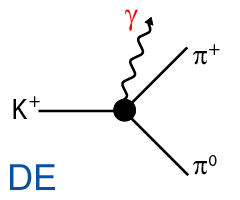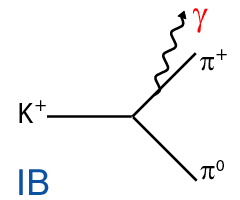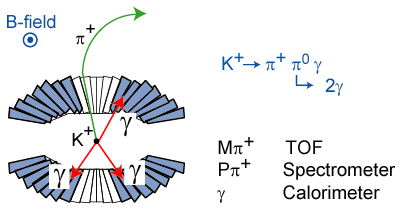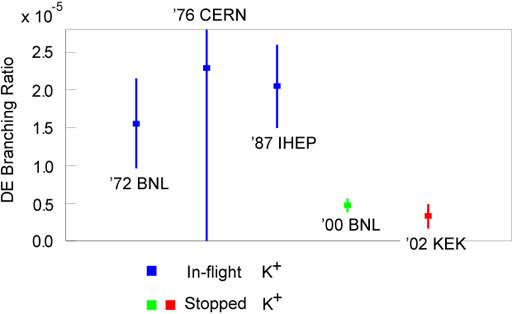
|

|
The chiral anomaly[1], which is a basic feature of quantum
field theory, has been the subject of extensive theoretical
investigation. Recently, this chiral anomaly can be treated in the
frame work of chiral perturbation theory (ChPT)
[2].
Since the
K+ → π+π0
decay is hindered as it
violates the Δ I=1/2 rule, the internal bremsstrahlung (IB) to
the radiative
K+ → π+π0γ
(Kπ2γ) decay
is also suppressed. This feature, in turn, enhances the direct
emission (DE) which is sensitive to the chiral anomaly. Four
experiments [
3,
4,
5,
6]
have reported on the DE branching ratio in the region of
55 < Tπ+ < 90 MeV, where
Tπ+ is the π+
kinetic energy. These experiments restrict the
π+ energy region to remove backgrounds from
K+ → π+π0π0
Therefore, we measured the Kπ2γ
events by extending the Tπ+
region below the Kπ3
end-point energy
Tπ+max = 55 MeV.

|

|
The experiment was performed at the KEK 12 GeV proton synchrotron in
2001 and we ran the experiment for about 100 shifts (∼ 1
month). The Kπ2γ data were collected with the
experimental apparatus based on the E246 experiment searching for
T-violation in
K+ → π0μ+ν
decay[7].
A Pb-plastic
sandwich detector with 2.6 radiation length was newly set at the outer
radius of the magnet pole to monitor photons escape from the photon
detector holes. The kaons were slowed down by a degrader and stopped
in the target. The Kπ2γ were identified
by analyzing the
π+ momentum with the spectrometer and detecting
three photons in the CsI(Tl) calorimeter.
The most important point to reconstruct Kπ2γ
was to
determine which photons were a pair from a π0,
because there are
three combinations to form the π0.
The pair which satisfies the Kπ2γ
kinematics was adopted as the correct π0 pair.
However, because of the finite kinematical resolution, the correct
pairing probability was 85% for IB and 79% for DE.
Since Kπ3
and Kπ2 decays do not satisfy the
Kπ2γ
kinematics, these backgrounds can be rejected by this analysis.

|
The number of good Kπ2γ events is 4434.
The experimental
Kπ2γ spectra are shown in Figure.
In order to obtain the detector acceptance and response functions, the
Monte Carlo simulation was performed using a GEANT-based Monte Carlo
code. The background fraction of the Kπ3
decay was estimated to be 1.2% from the simulation.
The DE branching ratio was determined using the three observables,
cosθπ+γ,
cosθπ0γ, and
Eγ which have characteristic spectra
corresponding to the decay processes. The experimental distribution
ρ(cosθπ+γ,
cosθπ0γ,
Eγ)
was fitted to the simulation spectrum of
IB[1+α(DE/IB)] with α being free parameters.
The fitted spectra and the sole DE components are also shown in
Figure. We determined the DE branching ratio to be
[9]
Br(DE, total) =
[6.1 ± 2.5(stat.) ± 1.9(syst.)]×10-6
.
In order to compare this result with the previous ones, the partial branching ratio in the region of 55 < Tπ+ < 90 MeV was also derived as [9]
Br(DE, partial) =
[3.2 ± 1.3(stat.) ± 1.0(syst.)] ×10-6
which is consistent with the previous stopped experiment[6]. |
|
| Figure: Kπ2γ spectra: (a) π+momentum, (b) opening angle between π+ and γ3, (c) opening angle between π0 and γ3, (d) γ3 energy. |
